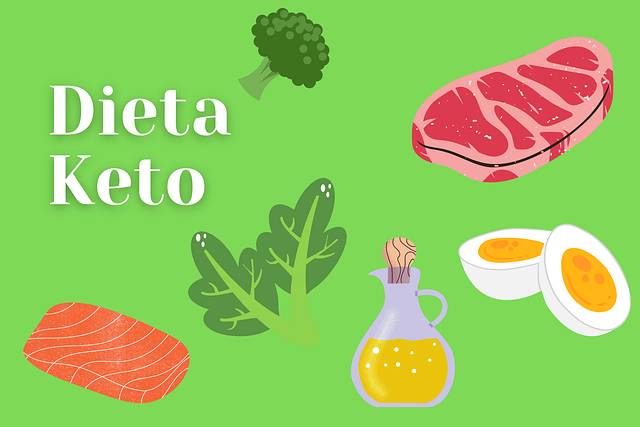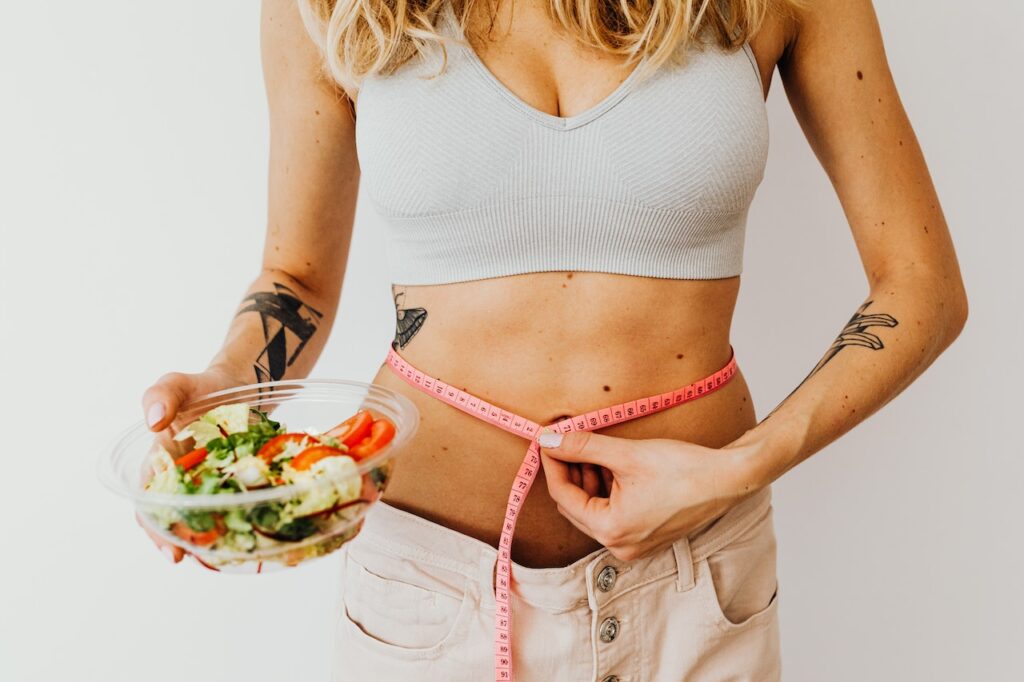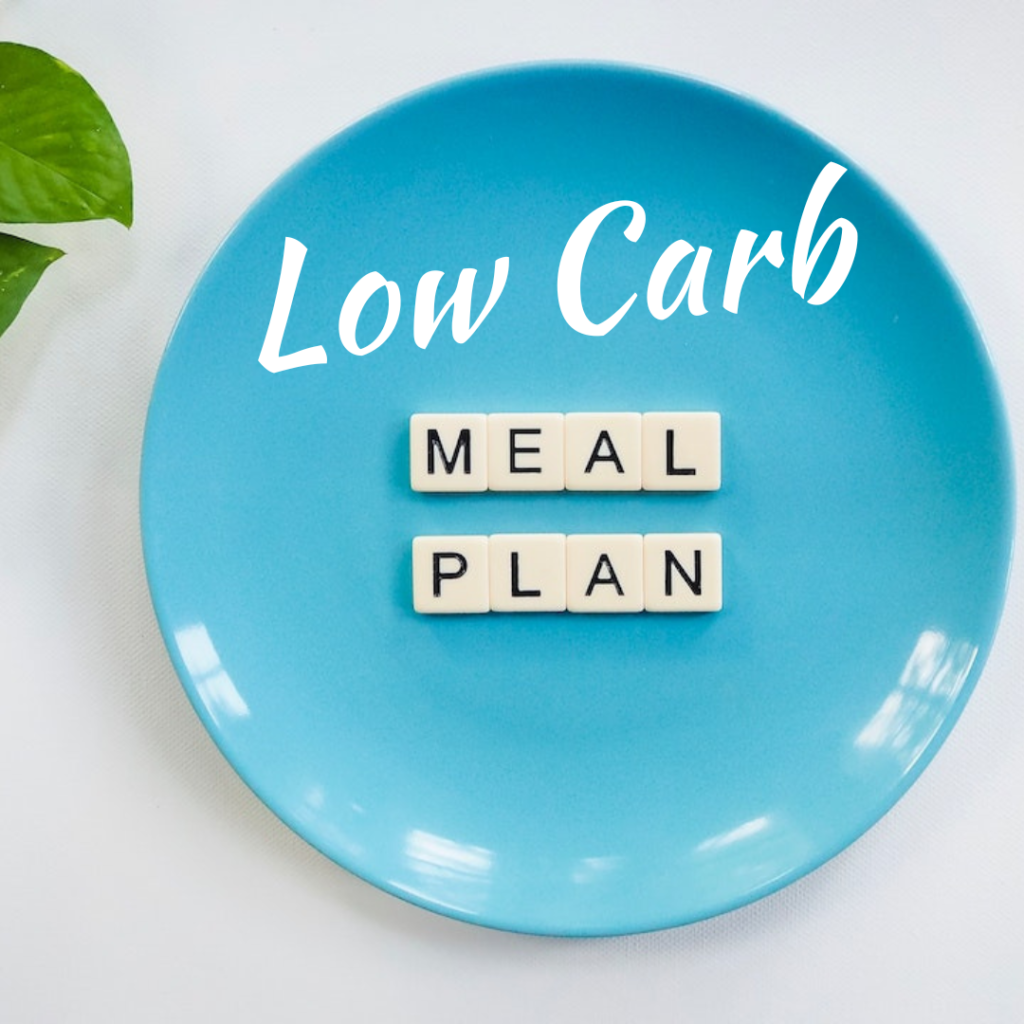If you are new to keto or have a question:
"How do i start a keto diet for beginners?"
You've arrived to the right location.
Think of this page as your comprehensive ketogenic diet guide.
You'll discover step by step how keto diet works, how to prepare dishes, what foods to eat, how to prevent side effects, and more.
Also you'll know the reasons why so many people continue to lose weight while in ketosis.
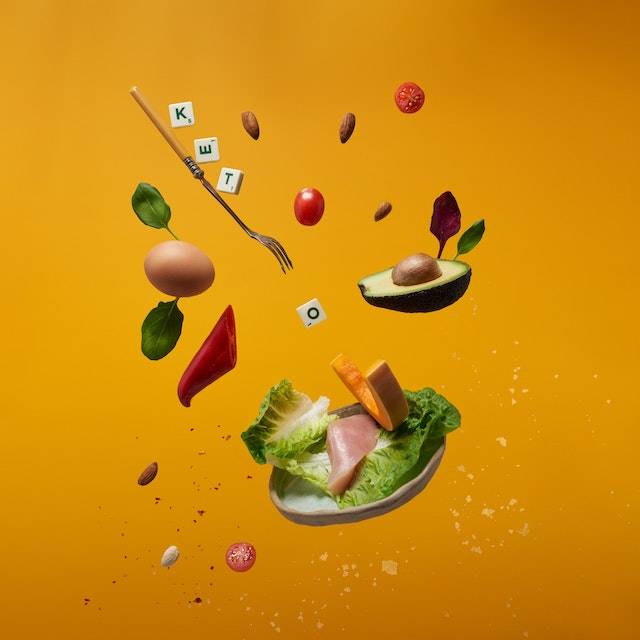
At the first step you should understand how this diet works.
Step1: How ketogenic diet works
Imagine your body as a car to help you comprehend why a ketogenic diet or being in ketosis can help you burn fat more effectively. Your body converts food into glucose, which it uses as fuel to produce energy.
What transpires, then, if your body isn't able to use all the glucose it has? After all, gasoline is necessary for your car to run.
Fortunately, your body doesn't experience that. Your liver produces ketones, a backup fuel, from fat, putting your body in a condition known as ketosis.
You consume a diet high in fat when you follow a ketogenic diet because you limit your intake of protein and carbohydrates. You won't have much glucose for fuel if you don't consume enough carbohydrates or protein. Your body converts the fat you consume into that backup fuel.
You are actually utilizing fat as fuel!
You constantly produce ketones. However, when you follow a ketogenic diet, your body starts using ketones instead of glucose as its primary fuel instead, and you enter ketosis.
It may take days or weeks to transition from glucose to ketones, and maintaining it might be difficult. Protein in excess or even little amounts can prevent your body from staying in ketosis.
Step 2: What are the basic rules for keto?
Following that plan calls for:
- maintaining a high fat consumption. You'll need an 80–90% fat diet to enter and stay in ketosis. In other words, dietary fats will make up the majority of your diet.
- watching your protein intake. Protein in excess can be converted to glucose, which prevents ketosis. On a ketogenic diet, you'll cut back on your protein consumption.
- limiting the amount of carbohydrates consumed. You must limit your daily carbohydrate consumption to between 20 and 50 grams if you want to stay in ketosis. To put that in context: About 25 grams of carbohydrates are included in an apple.
Keto diets can be difficult, at least initially. But some followers fervently affirm their advantages for losing weight and many other things.
Unlimited access!
Download our 21 Free Keto Recipes and get instant access to 14-Day Meal Plan, food list and more bonuses ...
Step 3: What should I do the first week of keto and before?
At first, before to beginning to eat or discard anything deemed non-keto. Make room in the refrigerator and pantry on one side for "your stuff" if not everyone in the family is following the ketogenic diet.
As soon as you begin your diet, ignore the remaining food in the pantry and refrigerator. Don't forget to fill your cupboard with the greatest keto staples.
Don’t make individual meals. Try deconstructed meals instead so everyone of your family can eat it.
Make a list of meals to sample for that. It will be much simpler to choose a snack you won't regret if you have a list of Keto-friendly options.
Step 4: What food should you choose?
What to eat on a keto diet is one of the most frequently asked topics when someone starts the diet. Fortunately, this is one of the simplest questions to answer with the correct tools.
In actuality, the keto diet is arguably the most adaptable and sustainable eating approach available. You don't need to feel deficient, uninterested, or constrained. Also, it doesn't have to be difficult.
Best foods for keto diet
Look at this simple infographic and share ...
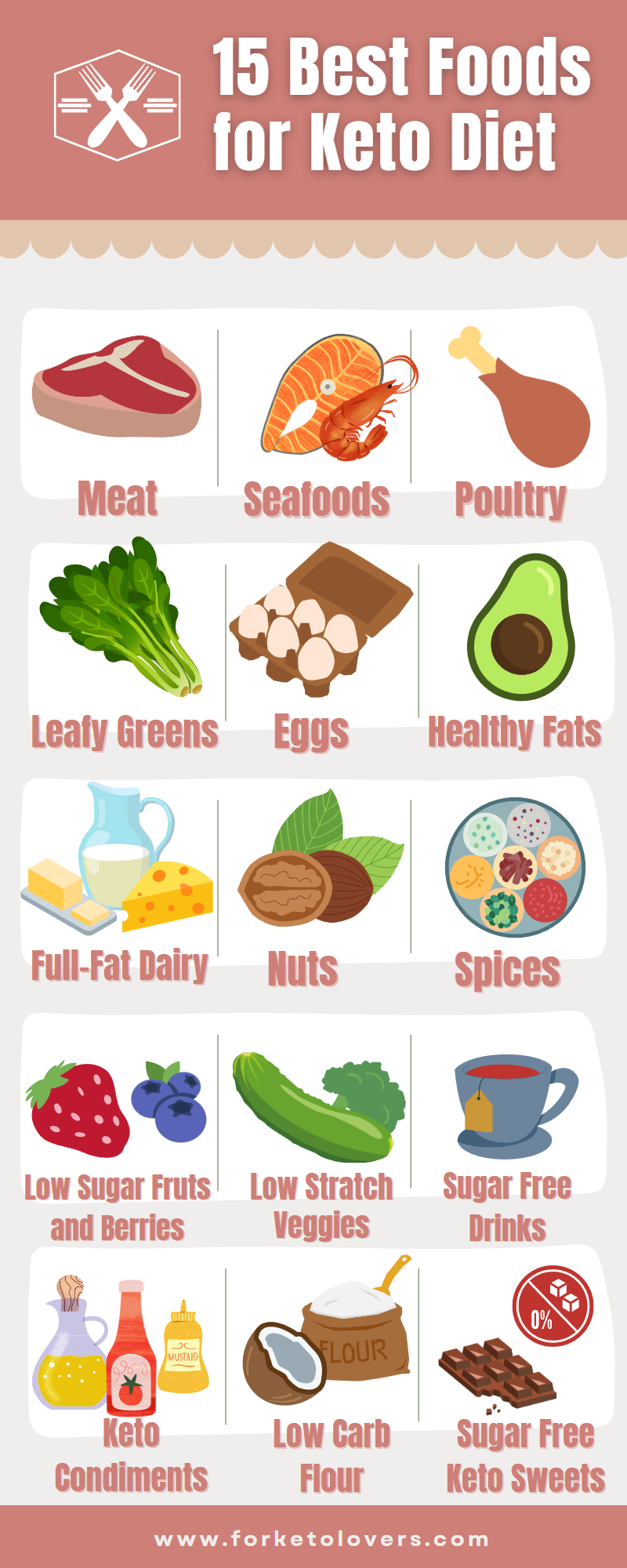
- Avocado oil, olive oil, butter, and coconut oil are all good sources of healthy fat.
- Leafy vegetables including kale, spinach, and lettuce
non-starchy veggies like celery, asparagus, peppers, broccoli, cauliflower, and many others that are grown above ground. Some underground veggies, like onions, are also acceptable. - Meat such as lamb, hog, and beef
- Chicken, turkey, and other poultry
- Salmon and other fish, shrimp, crab, and lobster are examples of seafood.
- heavy cream, cream cheese, and other full-fat dairy products.
- Eggs
- Beverages without sugar, such as coffee, tea, and water
- Herbs and seasonings like cinnamon, dill, and basil
- Mustard, spicy sauce, and mayonnaise are examples of low-carb condiments.
Also you can use more products to moderate your meals and make it taste...
- Avocados, berries of all sorts, coconuts and other fruit that shouldn't be consumed in moderation.
- Seeds and nuts such as sunflower seeds, chia seeds, macadamia nuts, and almonds.
- Sweeteners without sugar such erythritol, monk fruit, stevia, and allulose.
- Low-carb flours such psyllium husk powder, coconut flour, and almond flour
These are the fundamentals of the keto diet, and it's recommended to start out easy with mostly meat, eggs, fats, and vegetables.
Keto diet foods to avoid
The biggest change for anyone beginning a ketogenic or low-carb diet is likely to be cutting off carbohydrates. Many of us were accustomed to eating carbohydrates with each meal. Here is a list of foods to stay away from:
- Grains, such as corn, wheat, bread, pasta, oats, and cereal.
- Sugar — including table sugar, honey, maple syrup, soda, juice, candies, pastries, cakes, ice cream, and chocolate.
- Vegetables with a high starch content, such as potatoes, sweet potatoes, parsnips, etc.
- Beans, lentils, chickpeas, and other legumes In moderation, peanuts are an exception.
- Fruits with a lot of sugar, such as bananas, pineapple, oranges, apples, grapes, etc.
- Low-fat dairy products and milk, such as low-fat cheese and all forms of cow's milk (but heavy cream is acceptable).
- Margarine, canola oil, corn oil, grapeseed oil, and soybean oil are among the seed and vegetable oils.
- Processed "low carb" foods: contents matter, therefore check labels for sugar, starch, and artificial ingredients that may be hidden.
If you can, get these out of your home! Store these items in a different location from other foods.
Additionally, always read the labels on any food that has them. Keep an eye out for ingredients with names like dextrose, maltodextrin, maple syrup, honey, corn syrup, cornstarch, potato flakes, etc. that indicate the presence of additional sugar or starch.
You'll occasionally be surprised where additional sugars can be found.
Step 5: Make a keto diet menu
Know exactly when and what you'll be eating. Choose a few simple recipes, then get cooking. You will develop a love for meal planning and preparation after a few weeks on the keto diet.
To get you started, here are a couple of my recipes and meal preparation instructions:
- 10 Easy Keto Dinner Recipes That’ll Help You Lose Weight
- 10 Keto Desserts Recipes With Coconut Flour [Quick & Easy]
- 21 Free Keto Recipes E-book ( download this keto recipes and get instant access to our 14-DAY Keto Meal Plan)
- 30+ Quick Easy Keto Snacks Ideas “On The Go” [Best Recipes]
- 17 lazy keto breakfast Ideas To Best Start Your Day
- You can find some good ideas for breakfast and lunch on our Pinterest account ... like this ...
- Here are some snack suggestions in the infographic below if you feel hungry when keto ...
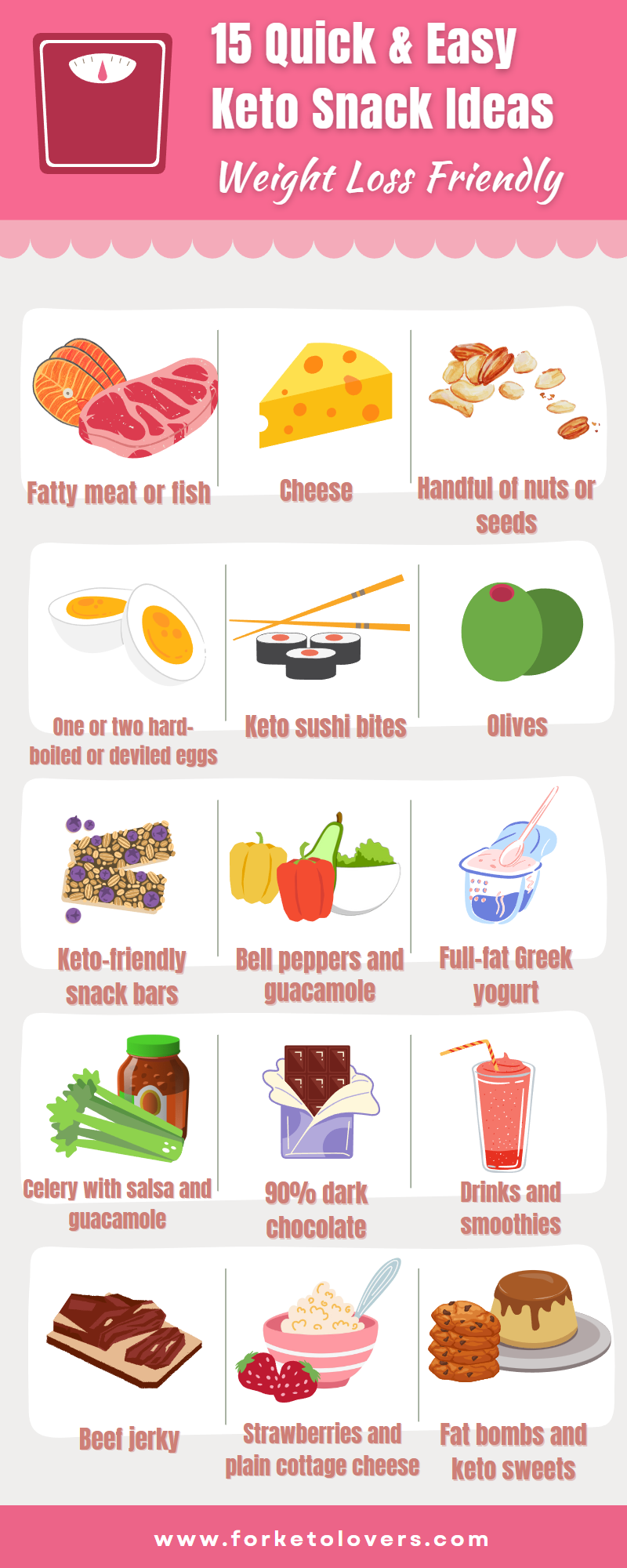
And here is one of our keto menu for one day ...
One Day Keto Menu
- lemon water or green juice or smoothie after wake up;
- breakfast - 2 hard boiled eggs with some chilly pepper or this variant of eggs meal
- for the lunch you can make shrimp or salmon with asparagus in the oven like this recipe... or one recipe from our tasty lunches. You can cook also one of our 20 keto salads recipes for the lunch.
- dinner - Keto Pizza or keto sushi bowl
Step 6: Join the keto diet easily
Most dieters would believe that it is best to approach this with 100% of their effort. But some experts advise against doing this.
The two major objectives are to practice using a food scale and to measure calories and carbs using a program like Carb Manager or Cron-o-meter.
Reduce your daily carbohydrate intake and portion sizes gradually during the first week of your diet.
You won't need to track your diet as much once you get in the habit of eating the same snacks and meals every day. When making a restaurant order, a food monitoring software will also come in helpful to double check the carb amount!
Keeping track of your diet is crucial if you're trying to lose weight, so become quite comfortable with it.
Does keto diet make you loss weight fast? ... read what experts says ...
Step 7: Understand the potential side effects of keto and what to do
Going keto could appear to be the best diet strategy. Your entire health is improved, you have more energy, and you literally burn body fat for fuel.
But even the ketogenic diet has its limitations. These are some of the critiques and possible responses:
1. The strategy seems constrictive
Including eggs, avocados, and nuts in your diet to lose weight? It can initially seem ideal that way. However, after a few weeks on the ketogenic diet, you might crave comfort food. Legumes, a lot of fruits, carbohydrates, and other favored foods are restricted or even avoided on ketogenic diets.
Solution: Increase the variety of your plan. Vegetables of all kinds can be incorporated into a ketogenic diet. Try fermented foods like kimchi and sauerkraut as well as starch substitutes that are suitable for the keto diet, like our mashed faux-potatoes.
2. You eat too many calories every day
High-fat meals, which are a mainstay of ketogenic diets, have more calories. If you consume too many calories, your body will start burning dietary fat rather than body fat, which could impede weight reduction.
Solution: Track everything you consume, as well as how you feel and any symptoms that appear. You'll be held responsible, and you might be surprised by how many calories you're consuming!
According to one study, participants who kept track of everything they ate lost twice as much weight as those who didn't.
3. The keto flu
This could happen as your body transitions from consuming glucose to utilizing ketones; the keto flu is as terrible as it sounds. Constipation, headaches, exhaustion, and sugar cravings are some of the symptoms. Keto flu does not affect all people. Those who do typically have these and other symptoms subside within a week or a few days.
Solution: Ensure that you're consuming enough pure, filtered water. Numerous keto flu symptoms are brought on by mineral deficiencies or electrolyte abnormalities. Consume foods high in minerals, such as avocado, almonds, and seeds. Consider sipping on "hard" waters because they still contain all of their minerals. Your food should be seasoned with mineral-rich Himalayan sea salt. Regularly consume bone broth, which is mineral-rich.
Numerous of these issues typically disappear over time. People eventually lose the weight they've been trying to lose and feel better, look better, become healthier.
Have a strategy after keto
According to a poll of nearly 34,000 people, a staggering 46% of American adults still consume a diet that the American Heart Association considers to be "bad."
Going on a ketogenic diet can be an attempt to kick bad behaviors for some people, but once the diet is finished, there is always the possibility of reverting to old patterns. Any health advantages will probably be lost if you immediately return to a typical American diet, and you'll probably gain the weight back.
All that being said, a severe warning: Although specialists do not advise it, some people attempt to prepare themselves to follow a ketogenic diet over the long term.
While keto diets do offer benefits for certain people, a 2021 assessment of pertinent studies cautioned against it. For instance, a keto diet can help you lose weight, but so can a lot of other nutritional plans.
Your ultimate objective, if you want to temporarily try a ketogenic diet, should be to "change your diet to a better pattern."
It may be a lazy keto diet that calls for consuming less bread, pasta, wheat, and sugar while increasing your intake of no starchy vegetables and other foods.
Conclusion: How do i start a keto diet for beginners
The keto diet can be helpful, pleasant, and surprisingly simple to adhere to.
But before making a significant shift, as always, see your doctor (ideally one who supports and understands a ketogenic diet), especially if you take any medications.
Use this tutorial to learn about the fundamentals of the keto diet if you have the all-clear.
Your New Keto Secret Tools
Subscribe today and get access to Best Keto Library

